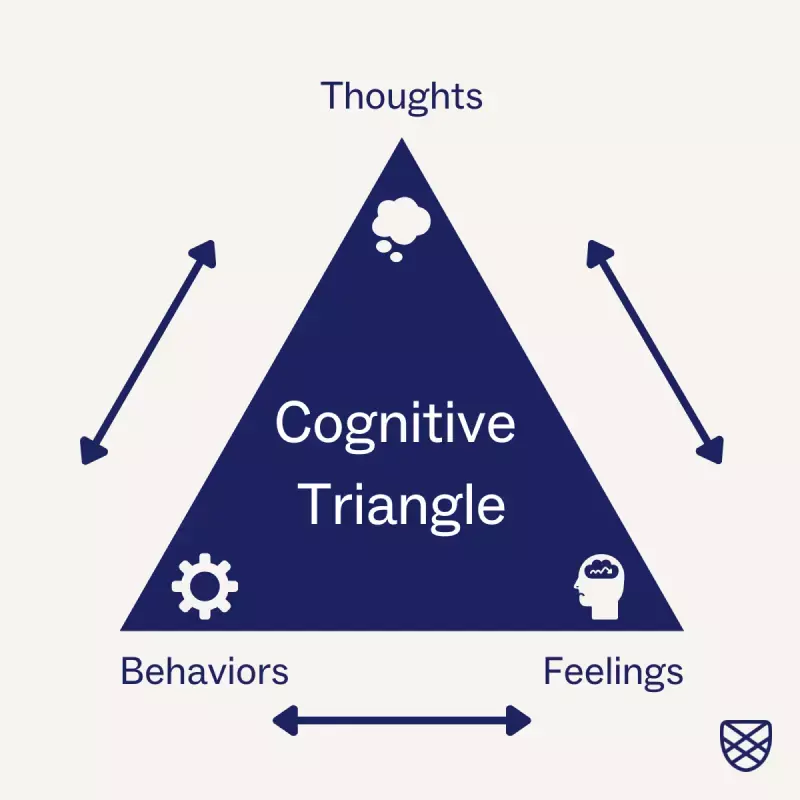
Table of Contents
The CBT Triangle Could Help Improve Your Mental Health

Written By: Amanda Lundberg

Clinically Reviewed By: Dr. Don Gasparini
Updated: February 21, 2024
5 min.
This cognitive behavioral therapy (CBT) tool helps you understand how your thoughts, feelings, and behaviors are connected.
Learn more about our Clinical Review Process
Table of Contents
The CBT triangle, also known as the cognitive triangle, is a visual representation of how thoughts, feelings, and behaviors affect each other, shaping how we experience and react to situations. This CBT tool is used to help people identify a negative thought (also known as a cognitive distortion) and manage any feeling or behavior that happens in response to the thought pattern. Below, we delve further into what the CBT triangle is and how it can be used to improve mental health.
Join the Charlie Health Library
Get mental health updates, research, insights, and resources directly to your inbox.
You can unsubscribe anytime.
What is the CBT triangle?
As mentioned, The CBT triangle, or cognitive triangle, illustrates how thoughts, feelings, and behaviors are interconnected and influence one another in shaping our experiences and reactions to different situations. The interrelationship between these factors is at the root of many mental health challenges, including negative thinking patterns, obsessive-compulsive disorder, social anxiety, and more.

The cognitive triangle exists independently of CBT, yet it is a critical component that helps a cognitive behavioral therapist identify conditions that trigger a cascade of thoughts, emotions, and behaviors. Using the cognitive triangle with the support of a licensed mental health professional is a powerful strategy for addressing mental health disorders. It can help foster inner peace, promote clearer thinking, enhance relationships, and diminish anxiety.
What are the three parts of the cognitive triangle?
The three parts of the cognitive triangle are thoughts, feelings, and behaviors. Understanding the intricate interplay between these three components helps us see how they affect our mental health. This knowledge can help us recognize harmful thought patterns (also known as a cognitive distortion), change negative thoughts, manage our emotions, and develop healthier habits. Here’s a deeper explanation of the three parts of the cognitive triangle.
Thoughts
This section encompasses cognitive processes, beliefs, and interpretations that occur within our minds. It includes both thoughts we're aware of and ones we aren't. Our thoughts can be shaped by past experiences, culture, and biases. They affect how we see ourselves, others, and the world. Cognitive distortions, such as black-and-white thinking or catastrophizing, can skew our perception of reality and affect our emotional well-being.

Feelings
This section of the triangle looks at how we feel in response to our thoughts and what’s happening around us (external stimuli). Emotions can vary from happiness to sadness, anger, or worry. They can be fleeting or persistent, intense or subtle. Our emotional experiences are influenced by a variety of factors, including our thoughts, past experiences, hormonal fluctuations, and social context. Understanding and accurately identifying our emotions is crucial for effective emotional regulation and mental health management.
Behaviors
This section focuses on the actions we take in response to our thoughts and feelings. Behaviors encompass both outward actions, such as how we interact with others or engage in activities, and internal responses, such as avoidance or rumination. Our behaviors are often driven by our thoughts and emotions, but the relationship can be bi-directional. Engaging in healthy behaviors, such as problem-solving or seeking social support, can promote well-being, while maladaptive behaviors, like substance abuse or self-isolation, can exacerbate mental health issues.
What are the applications of the CBT triangle?
Everyday life
Cognitive behavioral therapy
-
- Enhance mental well-being
-
- Manage stress
-
- Improve relationships
- Identify and challenge thoughts
- Regulate emotions
- Implement behavioral changes
The CBT triangle has many practical uses in both therapy and everyday life. By understanding how your thoughts, feelings, and behaviors interact, people can develop coping strategies, regulate their emotions, and make positive changes in their lives. Overall, it is a practical tool for enhancing mental well-being, managing stress, and improving relationships.
However, the CBT triangle is most effective when used in a therapeutic context, usually with the guidance of a cognitive behavioral therapist. In therapy, it serves as a guide for addressing various mental health issues like anxiety and depression by targeting negative thought patterns, managing emotions, and changing behaviors. Here’s an overview of how the CBT triangle can be used in therapy:
Identifying and challenging thoughts
Together, the therapist and client identify specific thoughts, emotions, and behaviors relevant to the client's presenting issues. They explore automatic thoughts (spontaneous, often negative thoughts), underlying beliefs, and cognitive distortions (repeated negative thoughts and beliefs that are difficult to recognize and trigger negative emotions). Some examples of cognitive distortions include:
- All-or-nothing thinking also called polarized thinking
- Using “should” statements, such as believing you “should never make a mistake”
- Catastrophizing or seeing the worst outcome in every situation
- Holding yourself responsible for acts or events beyond your control
- Labeling yourself or others based on limited evidence
The therapist helps the client challenge and reframe unhelpful or distorted thoughts using cognitive restructuring techniques. They encourage the client to examine the evidence for and against their thoughts, consider alternative perspectives, and develop more balanced and realistic interpretations of negative thought patterns.
Emotion regulation
Clients learn strategies for managing their emotions more effectively. This may involve identifying triggers for emotional distress, practicing mindfulness and relaxation techniques, and developing coping strategies for regulating intense emotions.

Behavior activation
Clients work on implementing behavioral changes to improve their mood and functioning. This may include setting specific behavioral goals, scheduling enjoyable and meaningful activities, and gradually confronting feared or avoided situations.
Between sessions, clients are often assigned homework exercises to practice the skills and strategies learned in therapy. These may include keeping thought records, practicing relaxation techniques, or engaging in behavioral experiments to test out new ways of thinking and behaving.
How Charlie Health can help
If you or a loved one is struggling with negative thought patterns or mental health issues, Charlie Health is here to help. Charlie Health’s virtual Intensive Outpatient Program (IOP) provides more than once-weekly mental health treatment for young people and families dealing with a range of complex mental health conditions. Our expert clinicians incorporate evidence-based therapies and resources (including the cognitive behavioral therapy triangle) into individual counseling, family therapy, and group sessions. With this kind of holistic treatment, managing your mental health and feeling your best is possible. Fill out the form below or give us a call to start healing today.





